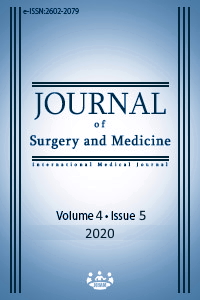Relationship between blood pressure levels during thrombolytic therapy and functional outcomes in patients with middle cerebral artery infarction
Keywords:
Acute ischemic stroke, Blood pressure, Intravenous thrombolytic therapy, Middle cerebral artery infarction, Functional outcomes, Modified Rankin scaleAbstract
Aim: Previous studies have investigated the relationship between blood pressure (BP) level before and after intravenous (IV) thrombolytic therapy, and functional outcomes of acute ischemic stroke (AIS). However, the relationship between BP level during thrombolytic infusion and functional outcomes has not been well studied. Therefore, in this study, we investigated the relationship between BP levels during thrombolytic therapy and functional outcomes at the 3rd month in AIS patients with middle cerebral artery (MCA) infarction.
Methods: This case-control study was conducted on 60 patients with infarcts in more than 1/3 of MCA. Among these, 20 patients underwent IV thrombolytic therapy after giving informed consent (study group). Forty patients who did not receive thrombolytic therapy were included in the control group. Patients undergoing IV thrombolytic therapy were divided into two groups according to modified Rankin Scale (mRS) at the 3rd month: Those with good functional outcomes (mRS score=0–2) and poor functional outcome (mRS score=3–6).
Results: The poor functional outcome group had a higher mean diastolic BP than the good functional outcome group (P=0.01). Systolic BP was <140 mmHg and diastolic BP was <75 mmHg in the good functional outcome group. A significant, positive, and moderate correlation was found between the mRS score and diastolic BP at the time of admission to the emergency department (r=0.679, P=0.001), immediately before (r=0.580, P=0.007), and during IV thrombolytic therapy (r=0.643, P=0.002).
Conclusion: In AIS patients with MCA infarction, high diastolic BP levels during IV thrombolytic therapy are associated with poor functional outcomes.
Downloads
References
National Institute of Neurological Disorders and Stroke rt-PA Stroke Study Group. Tissue plasminogen activator for acute ischemic stroke. N Engl J Med. 1995;333(24):1581-7.
Demaerschalk BM, Kleindorfer DO, Adeoye OM, Demchuk AM, Fugate JE, Grotta JC, et al. on behalf of the American Heart Association Stroke Council and Council on Epidemiology and Prevention. Scientific rationale for the inclusion and exclusion criteria for intravenous alteplase in acute ischemic stroke: a statement for healthcare professionals from the American Heart Association/American Stroke Association [published correction appears in Stroke. 2016;47:e262]. Stroke. 2016;47:581–641. doi: 10.1161/STR.0000000000000086.
Powers WJ, Rabinstein AA, Ackerson T, Adeoye OM, Bambakidis NC, Becker K, et al. American Heart Association Stroke Council. 2018 Guidelines for the Early Management of Patients With Acute Ischemic Stroke: A Guideline for Healthcare Professionals From the American Heart Association/American Stroke Association. Stroke. 2018;49(3):e46-e99. doi: 10.1161/STR.0000000000000158.
Teng RSY, Tan BYQ, Miny S, Syn NL, Ho AFW, Ngiam NJH, et al. Effect of Pretreatment Blood Pressure on Outcomes in Thrombolysed Acute Ischemic Stroke Patients: A Systematic Review and Meta-analysis. J Stroke Cerebrovasc Dis. 2019;28(4):906-19. doi: 10.1016/j.jstrokecerebrovasdis.2018.12.008.
Whelton PK, Carey RM, Aronow WS, Casey DE Jr, Collins KJ, Dennison Himmelfarb C, et al. ACC/AHA/AAPA/ABC/ACPM/AGS/APhA/ASH/ASPC/ NMA/PCNA Guideline for the Prevention, Detection, Evaluation, and Management of High Blood Pressure in Adults: A Report of the American College of Cardiology/ American Heart Association Task Force on Clinical Practice Guidelines. Hypertension. 2018;71(6):e13-e115. doi: 10.1161/HYP.0000000000000065.
Şimşek BK, Özer G . Evaluation of stroke mortality and related risk factors: A single-center cohort study from Gaziantep, Turkey. J Surg Med. 2019;3(3):231-4. doi: 10.28982/josam.534758
Rankin L. Cerebral vascular accidents in patients over the age of 60. II. Prognosis. Scott Med J. 1957;2:200–15.
van Swieten JC, Koudstaal PJ, Visser MC, Schouten HJ, van GJ. Interobserver agreement for the assessment of handicap in stroke patients. Stroke. 1988;19:604–7.
Luan X, Qiu H, Hong X, Wu C, Zhao K, Chen H, et al. High serum nerve growth factor concentrations are associated with good functional outcome at 3 months following acute ischemic stroke. Clin Chim Acta. 2019;488:20-4. doi: 10.1016/j.cca.2018.10.030.
Saqqur M, Uchino K, Demchuk AM, Molina CA, Garami Z, Calleja S, et al. for CLOTBUST Investigators. Site of arterial occlusion identified by transcranial Doppler predicts the response to intravenous thrombolysis for stroke. Stroke 2007;38:948-54.
NINDS t-PA Stroke Study Group: Generalized efficacy of t-PA for acute stroke. Subgroup analysis of the NINDS t-PA Stroke Trial. Stroke. 1997;28:2119–25.
Gilligan AK, Markus R, Read S, Srikanth V, Hirano T, Fitt G, et al. Australian Streptokinase Trial Investigators. Baseline blood pressure but not early computed tomography changes predicts major hemorrhage after streptokinase in acute ischemic stroke. Stroke. 2002;33(9):2236-42.
Brott T, Lu M, Kothari R, Fagan SC, Frankel M, Grotta JC, et al. Hypertension and its treatment in the NINDS rt-PA Stroke Trial. Stroke. 1998;29(8):1504-9.
Liu K, Yan S, Zhang S, Guo Y, Lou M. Systolic Blood Pressure Variability is Associated with Severe Hemorrhagic Transformation in the Early Stage After Thrombolysis. Transl Stroke Res. 2016;7(3):186-91. doi:10.1007/s12975-016-0458-6.
Anderson CS, Huang Y, Lindley RI, Chen X, Arima H, Chen G, et al. Intensive blood pressure reduction with intravenous thrombolysis therapy for acute ischaemic stroke (ENCHANTED): an international, randomised, open-label, blinded-endpoint, phase 3 trial. Lancet. 2019;393(10174):877-88. doi:10.1016/S0140-6736(19)30038-8.
Buijs JE, Uyttenboogaart M, Brouns R, de Keyser J, Kamphuisen PW, Luijckx GJ. The Effect of Age and Sex on Clinical Outcome after Intravenous Recombinant Tissue Plasminogen Activator Treatment in Patients with Acute Ischemic Stroke. J Stroke Cerebrovasc Dis. 2016;25(2):312-16. doi: 10.1016/j.jstrokecerebrovasdis. 2015.09.035.
Hess DC, Wang S, Hamilton W, Lee S, Pardue C, Waller JL, et al. REACH: clinical feasibility of a rural telestroke network. Stroke. 2005;36(9):2018-20. doi: 10.1161 /01.STR.0000177534.02969.e4
California Acute Stroke Pilot Registry (CASPR) Investigators. Prioritizing interventions to improve rates of thrombolysis for ischemic stroke. Neurology. 2005;64:654–9. doi: 10.1212/01.WNL.0000151850.39648.51
Anderson BE, Rafferty AP, Lyon-Callo S, Fussman C, Reeves MJ. Knowledge of tissue plasminogen activator for acute stroke among Michigan adults. Stroke. 2009;40(7):2564-7. doi: 10.1161/STROKE AHA.108.545988.
Downloads
- 596 1611
Published
Issue
Section
How to Cite
License
Copyright (c) 2020 Muzaffer Güneş
This work is licensed under a Creative Commons Attribution-NonCommercial-NoDerivatives 4.0 International License.
















